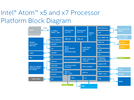Intel HD Graphics 5500 vs Intel HD Graphics 4000 vs Intel HD Graphics (Cherry Trail)
Intel HD Graphics 5500
► remove from comparison
Die Intel HD Graphics 5500 (GT2) ist eine Prozessorgrafikkarte in den CPUs der Broadwell-Generation. Die GPU wird in einigen ULV-Modellen (15 Watt) der Core-i3-, Core-i5- und Core-i7-Serie verbaut und verfügt im Regelfall über 24 EUs (Core i3: 23 EUs). Die maximale Turbo-Taktrate der Grafikkarte hängt vom konkreten Modell ab und liegt zwischen 850 und 950 MHz.
Architektur und Features
Broadwell integriert eine Grafikeinheit auf Basis der Intel-Gen8-Architektur, die gegenüber dem Vorgänger Intel Gen7.5 (Haswell) in verschiedenen Punkten weiterentwickelt wurde. So hat Intel unter anderem die "Subslice" genannten Shader-Arrays umorganisiert, die nun jeweils 8 Execution Units (EUs) beinhalten. Drei Subslices bilden wiederum einen Slice mit insgesamt 24 EUs. Hinzu kommen größere L1-Caches und Verbesserungen im Front-End, die die Leistung zusätzlich steigern sollen.
Die HD Graphics 5500 repräsentiert die mittlere, auch "GT2" bezeichnete Ausbaustufe mit einem Slice und 24 EUs. Eine Ausnahme bilden die Core-i3-Modelle, bei denen – mutmaßlich zur Steigerung der Ausbeute – lediglich 23 EUs aktiviert sind. Daneben existieren auch eine teildeaktivierte GT1-Variante (12 EUs) sowie die GT3/GT3e (48 EUs) ohne/mit zusätzlichem eDRAM-Cache.
Alle Broadwell-GPUs unterstützen OpenCL 2.0 sowie DirectX 12 (FL 11_1). Zudem kann der Videodecoder nun auch den H.265-Codec verarbeiten, greift dafür allerdings nur teilweise auf besonders sparsame Fixed-Function-Einheiten zurück. Die Bildausgabe erfolgt über DP 1.2/eDP 1.3 (max. 3.840 x 2.160 @ 60 Hz) oder HDMI 1.4a (max. 3.840 x 2.160 @ 24 Hz), HDMI 2.0 steht dagegen nicht zur Verfügung. Es können maximal drei Displays parallel angesteuert werden.
Performance
Je nach Modell liegt der maximale GPU-Takt zwischen 850 und 950 MHz, der aufgrund der niedrigen TDP jedoch nicht immer vollständig ausgeschöpft werden kann. Einen ebenfalls großen Einfluss auf die Performance hat die Speicheranbindung: Ohne schnellen DDR3-1600-RAM im Dual-Channel-Modus kann die Leistung mehr als 20 Prozent schlechter ausfallen.
Mit Dual-Channel-Speicher übertrifft die HD Graphics 5500 die HD Graphics 4400 (Haswell, 20 EUs) um etwa 20 bis 25 Prozent und schlägt sogar die HD Graphics 5000 (Haswell, 40 EUs). Allerdings rechnet bereits eine dedizierte Low-End-Karte wie die GeForce 820M je nach Spiel zwischen 10 und 30 Prozent schneller. Aktuelle Spiele des Jahres 2014/2015 werden zumeist nur in niedrigsten Einstellungen flüssig dargestellt.
Leistungsaufnahme
Die TDP des gesamten Chips liegt standardmäßig bei 15 Watt, sodass die HD Graphics 5500 vor allem in kompakten Ultrabooks zu finden ist. Abhängig vom jeweiligen Modell kann die TDP auch auf noch niedrigere Werte (7,5 oder 10 Watt) abgesenkt werden, was sich jedoch negativ auf die Leistungsfähigkeit auswirkt.
Intel HD Graphics 4000
► remove from comparison
Die Intel HD Graphics 4000 (GT2) ist eine Prozessorgrafikkarte in den CPUs der Ivy Bridge Generation (3. Generation von Intel Core z.B. Core i7-3770). Je nach Prozessormodell wird die Intel HD Graphics 4000 unterschiedlich getaktet (und kann auf den unterschiedlich großen Cache zurückgreifen) und bietet daher eine teilweise deutlich geringe Leistung. Weiterhin kann die Taktung durch die Turbo Boost Technologie je nach Anforderung und TDP deutlich erhöht werden. In den schnellen Modellen soll der Basistakt 650 MHz und der Turbo 1.1 bis 1.25 GHz betragen. Die ULV Modelle weisen jedoch einen deutlich geringeren Basistakt auf (Sandy Bridge z.B. 350 MHz).
Im Vergleich zur HD Graphics 3000 der Sandy Bridge Prozessoren, bietet die 4000er einen eigenen Cache, überarbeitete DirectX 11 taugliche Shader (und vier mehr) und soll dadurch bis zu 60% mehr Leistung (3DMark Vantage) zeigen. Weiterhin sollte die GPU auf den gemeinsamen Last Level Cache (Level 3 Cache) des Prozessors zugreifen können. Weiters können die Shader auch für Direct Compute genutzt werden.
Erste Benchmarks positionieren die HD Graphics 4000 (in einem schnellen Desktop Quad-Core) auf dem Level einer Nvidia GeForce GT 330M und dadurch oberhalb der integrierten Prozessorgrafik Radeon HD 6620G. In unserem Unfangreichen Testbericht der HD Graphics 4000 konnte sie sich im schnellen Core i7-3820QM deutlich durchsetzen (6620G 15% langsamer). In den Mittelklassemodellen Core i7-3610QM und einem Dual-Core i5 war sie nur noch knapp schneller. Manchmal ist sogar eine langsame GeForce GT 630M in Reichweite. Gelegenheitsspieler, die bei Bedarf mit einer geringen Auflösung, deaktivierter Kantenglättung und niedrigen Settings leben können, werden daher an der HD Graphics 4000 durchaus Gefallen finden. In den ULV Prozessoren (Core ix-3xx7U) wird eine geringer getaktete Variante eingesetzt. Durch die TDP Beschränkungen kann der Turbo außerdem meistens nicht so hoch takten, wie bei den 35/45 Watt Versionen. Dadurch ist die HD Graphics 4000 hier meist etwa 30% langsamer als in schnellen Quad-Core CPUs.
Eine Besonderheit der Ivy Bride Grafikkerne ist, das nur 4x MSAA von der Hardware unterstützt wird. 2x MSAA wird per Software berechnet und geht durch die 4x MSAA Pipeline. Daher empfiehlt sich der Einsatz des gleich schnellen 4x MSAA.
Auch der integrierte Videodecoder genannt Multi Format Codec Engine (MFX) wurde kräftig überarbeitet und soll nun sogar mehrere 4K Videos parallel dekodieren können (ev nur in den High-End Modellen). DXVA Checker gibt weiterhin die Formate MPEG2, VC1, WMV9 und H264 als unterstütz an. QuickSync zum schnellen Transkodieren von Videos wurde ebenfalls verbessert und soll nun schneller bei gleichzeitig höherer Qualität laufen.
Ebenfalls neu ist die Unterstützung für drei unabhängige Bildschirme (abhängig von der Umsetzung im Notebook eventuell nur zwei gleichzeitige möglich). Bis jetzt waren nur zwei möglich und lediglich die AMD Grafikkarten mit Eyefinity Support bieten mehr als zwei Anschlüsse für Notebooks (jedoch nur mit DisplayPorts). Laut Intel wird DisplayPort in der Version 1.1 unterstützt (daher maximal 2560x1600) und HDMI in 1.4 (in der Praxis 1920x1080, siehe Fokusartikel für 2560x1600).
Der Stromverbrauch ist dank des 22nm Prozesses mit 3D Tri-Gate Technologie relativ gering und nicht einzeln angegeben. Die Notebook-Prozessoren (CPU, GPU, Speichercontroller) sind gesamt auf einen TDP von 18-45 Watt spezifziert.
Intel HD Graphics (Cherry Trail)
► remove from comparison
Die Intel HD Graphics (Cherry Trail) ist eine in den Tablet-SoCs der Cherry-Trail-Serie (z.B. Atom x7-Z8700) integrierte Grafikeinheit. Sie basiert auf der gleichen Architektur wie die GPU verschiedener Broadwell-Prozessoren (z.B. HD Graphics 5300), bietet allerdings deutlich weniger Shadereinheiten und geringere Taktraten. Die genauen Spezifikationen hängen vom jeweiligen SoC ab:
- Atom x7-Z8700: 16 EUs @ 200 - 600 MHz, Dual-Channel Memory
- Atom x5-Z8500: 12 EUs @ 200 - 600 MHz, Dual-Channel Memory
- Atom x5-Z8300: 12 EUs @ 200 - 500 MHz, Single-Channel Memory
Die schnellste Variante mit 16 EUs und maximal 600 MHz schlägt die ältere HD Graphics (Bay Trail) um Faktor zwei, womit sich die GPU etwas oberhalb einer Qualcomm Adreno 330 oder PowerVR G6430, jedoch deutlich unter einer Adreno 420 oder GX6450 einordnet. Auch Nvidias Tegra-SoCs K1 und X1 rechnen weitaus schneller.
Unter Windows werden sich Anwender deshalb weiter auf sehr alte und anspruchslose Spiele beschränken müssen, wohingegen moderne Android-Games auch in hohen Auflösungen zumeist flüssig dargestellt werden sollten. Der x7-Z8700 war z.B. nur knapp in der Lage Team Fortress 2 in minimalen Details und 1280x720 flüssig wiederzugeben (11 - 69 fps).
Videos kann die GPU auch in 4K/H.265 flüssig wiedergeben (je nach Bitrate und Farbtiefe).
Die Intel HD Graphics Grafikkarte in den Cherry Trail SoCs unterstützt nach unseren Tests mit dem MS Surface 3 mit Atom x7-Z8700 nur DisplayPort 1.1 und damit lediglich 30 Hz bei 4K (3.840 x 2.160).
| Intel HD Graphics 5500 | Intel HD Graphics 4000 | Intel HD Graphics (Cherry Trail) | ||||||||||||||||||||||||||||||||||||||||||||||||||||||||||||||||||||||||||||||||||||||||||||||||||||||||||||||||||||||||||||||||||||||||||||||||||||||||||||||||||||||||||||||||||||||||||||||||||||||||||||||||
| HD Graphics Serie |
|
|
| |||||||||||||||||||||||||||||||||||||||||||||||||||||||||||||||||||||||||||||||||||||||||||||||||||||||||||||||||||||||||||||||||||||||||||||||||||||||||||||||||||||||||||||||||||||||||||||||||||||||||||||||
| Codename | Broadwell GT2 | Ivy Bridge | Cherry Trail | |||||||||||||||||||||||||||||||||||||||||||||||||||||||||||||||||||||||||||||||||||||||||||||||||||||||||||||||||||||||||||||||||||||||||||||||||||||||||||||||||||||||||||||||||||||||||||||||||||||||||||||||
| Architektur | Gen. 8 Broadwell | Gen. 7 Ivy Bridge | Gen. 8 | |||||||||||||||||||||||||||||||||||||||||||||||||||||||||||||||||||||||||||||||||||||||||||||||||||||||||||||||||||||||||||||||||||||||||||||||||||||||||||||||||||||||||||||||||||||||||||||||||||||||||||||||
| Pipelines | 24 - unified | 16 - unified | 16 - unified | |||||||||||||||||||||||||||||||||||||||||||||||||||||||||||||||||||||||||||||||||||||||||||||||||||||||||||||||||||||||||||||||||||||||||||||||||||||||||||||||||||||||||||||||||||||||||||||||||||||||||||||||
| Kerntakt | 300 - 950 (Boost) MHz | 350 - 1350 (Boost) MHz | 200 - 600 (Boost) MHz | |||||||||||||||||||||||||||||||||||||||||||||||||||||||||||||||||||||||||||||||||||||||||||||||||||||||||||||||||||||||||||||||||||||||||||||||||||||||||||||||||||||||||||||||||||||||||||||||||||||||||||||||
| Speicherbandbreite | 64/128 Bit | 64/128 Bit | 64/128 Bit | |||||||||||||||||||||||||||||||||||||||||||||||||||||||||||||||||||||||||||||||||||||||||||||||||||||||||||||||||||||||||||||||||||||||||||||||||||||||||||||||||||||||||||||||||||||||||||||||||||||||||||||||
| Shared Memory | ja | ja | ja | |||||||||||||||||||||||||||||||||||||||||||||||||||||||||||||||||||||||||||||||||||||||||||||||||||||||||||||||||||||||||||||||||||||||||||||||||||||||||||||||||||||||||||||||||||||||||||||||||||||||||||||||
| API | DirectX 12 (FL 11_1), OpenGL 4.3 | DirectX 11, Shader 5.0, OpenGL 3.1 | DirectX 12 (FL 11_1), Shader 5.0, OpenGL 4.3 | |||||||||||||||||||||||||||||||||||||||||||||||||||||||||||||||||||||||||||||||||||||||||||||||||||||||||||||||||||||||||||||||||||||||||||||||||||||||||||||||||||||||||||||||||||||||||||||||||||||||||||||||
| Transistors | 1.3 Billion | |||||||||||||||||||||||||||||||||||||||||||||||||||||||||||||||||||||||||||||||||||||||||||||||||||||||||||||||||||||||||||||||||||||||||||||||||||||||||||||||||||||||||||||||||||||||||||||||||||||||||||||||||
| Herstellungsprozess | 14 nm | 22 nm | 14 nm | |||||||||||||||||||||||||||||||||||||||||||||||||||||||||||||||||||||||||||||||||||||||||||||||||||||||||||||||||||||||||||||||||||||||||||||||||||||||||||||||||||||||||||||||||||||||||||||||||||||||||||||||
| Features | Quick Sync | QuickSync | ||||||||||||||||||||||||||||||||||||||||||||||||||||||||||||||||||||||||||||||||||||||||||||||||||||||||||||||||||||||||||||||||||||||||||||||||||||||||||||||||||||||||||||||||||||||||||||||||||||||||||||||||
| Erscheinungsdatum | 05.01.2015 | 23.03.2011 | 02.03.2015 |
|
|
| ||||||||||||||||||||||||||||||||||||||||||||||||||||||||||||||||||||||||
Benchmarks
3DM Vant. Perf. total + Intel HD Graphics 5500
specvp11 snx-01 + Intel HD Graphics 5500
specvp12 sw-03 + Intel HD Graphics 5500
Cinebench R15 OpenGL 64 Bit + Intel HD Graphics 5500
GFXBench T-Rex HD Offscreen C24Z16 + Intel HD Graphics 5500
Average Benchmarks Intel HD Graphics 5500 → 100% n=18
Average Benchmarks Intel HD Graphics 4000 → 60% n=18
Average Benchmarks Intel HD Graphics (Cherry Trail) → 39% n=18
* Smaller numbers mean a higher performance
1 This benchmark is not used for the average calculation
Spiele-Benchmarks
Die folgenden Benchmarks basieren auf unseren Spieletests mit Testnotebooks. Die Performance dieser Grafikkarte bei den gelisteten Spielen ist abhängig von der verwendeten CPU, Speicherausstattung, Treiber und auch Betriebssystem. Dadurch müssen die untenstehenden Werte nicht repräsentativ sein. Detaillierte Informationen über das verwendete System sehen Sie nach einem Klick auf den fps-Wert.

Hunt Showdown
2020
Escape from Tarkov
2020
Hearthstone
2020
Need for Speed Heat
2019
Borderlands 3
2019
The Division 2
2019
Dirt Rally 2.0
2019
Far Cry New Dawn
2019
Metro Exodus
2019
Apex Legends
2019
Just Cause 4
2018
Darksiders III
2018
Battlefield V
2018
Farming Simulator 19
2018
Fallout 76
2018
Forza Horizon 4
2018
Monster Hunter World
2018
The Crew 2
2018
X-Plane 11.11
2018
Call of Duty WWII
2017
The Evil Within 2
2017
Ark Survival Evolved
2017
Team Fortress 2
2017
Rocket League
2017
Resident Evil 7
2017
Titanfall 2
2016
Farming Simulator 17
2016
Battlefield 1
2016
Doom
2016
Rainbow Six Siege
2015
Just Cause 3
2015
Fallout 4
2015
Anno 2205
2015
FIFA 16
2015
World of Warships
2015
Metal Gear Solid V
2015
Mad Max
2015
Dota 2 Reborn
2015
The Witcher 3
2015
Dirt Rally
2015
GTA V
2015
Battlefield Hardline
2015
Evolve
2015
The Crew
2014
Far Cry 4
2014
F1 2014
2014
The Evil Within
2014
Ryse: Son of Rome
2014
Alien: Isolation
2014
Fifa 15
2014
Sims 4
2014
Risen 3: Titan Lords
2014
GRID: Autosport
2014
Watch Dogs
2014
Titanfall
2014
Thief
2014
X-Plane 10.25
2013
Call of Duty: Ghosts
2013
Battlefield 4
2013
F1 2013
2013
Fifa 14
2013
Total War: Rome II
2013
Saints Row IV
2013
Dota 2
2013
Company of Heroes 2
2013
GRID 2
2013
Metro: Last Light
2013
BioShock Infinite
2013
SimCity
2013
Tomb Raider
2013
Crysis 3
2013
Dead Space 3
2013
Far Cry 3
2012
Assassin´s Creed III
2012
Hitman: Absolution
2012
Dishonored
2012
World of Tanks v8
2012
Fifa 13
2012
F1 2012
2012
Borderlands 2
2012
Torchlight 2
2012
Guild Wars 2
2012
Counter-Strike: GO
2012
Darksiders II
2012
Sleeping Dogs
2012
The Secret World
2012
Max Payne 3
2012
Dirt Showdown
2012
Diablo III
2012
Risen 2: Dark Waters
2012
Mass Effect 3
2012
Alan Wake
2012
Anno 2070
2011
Battlefield 3
2011
Batman: Arkham City
2011
Fifa 12
2011
F1 2011
2011
Dirt 3
2011
Crysis 2
2011
Mafia 2
2010
StarCraft 2
2010
Metro 2033
2010Average Gaming Intel HD Graphics 5500 → 100%
Average Gaming 30-70 fps → 100%
Average Gaming Intel HD Graphics 4000 → 99%
Average Gaming 30-70 fps → 118%
Average Gaming Intel HD Graphics (Cherry Trail) → 46%
| Intel HD Graphics (Cherry Trail) | low | med. | high | ultra | QHD | 4K |
|---|---|---|---|---|---|---|
| Team Fortress 2 | 21.4 | |||||
| Rocket League | 15.5 | |||||
| Farming Simulator 17 | 22.6 | |||||
| Rainbow Six Siege | 11.5 | 7 | ||||
| Star Wars Battlefront | 8.8 | 4.8 | ||||
| Anno 2205 | 8.1 | 3.9 | ||||
| World of Warships | 15 | |||||
| Metal Gear Solid V | 15.1 | 9.8 | ||||
| Dota 2 Reborn | 20 | 15.2 | 7.2 | |||
| Dirt Rally | 20.1 | 12.5 | ||||
| GTA V | 10.8 | |||||
| Dragon Age: Inquisition | 9.5 | 5.7 | ||||
| Civilization: Beyond Earth | 16.2 | 6.1 | ||||
| F1 2014 | 16 | 12 | ||||
| Fifa 15 | 15.6 | |||||
| Sims 4 | 71 | 16 | 8 | |||
| GRID: Autosport | 25 | 13 | ||||
| Battlefield 4 | 13.3 | |||||
| Asphalt 8: Airborne | 58 | 47 | ||||
| Dota 2 | 29.7 | 16.5 | ||||
| GRID 2 | 24 | 13.5 | ||||
| BioShock Infinite | 19 | 9 | 7 | 2 | ||
| Tomb Raider | 27 | 13 | 8 | 4 | ||
| Temple Run 2 | 34 | |||||
| Dishonored | 15.2 | 11.6 | ||||
| Borderlands 2 | 0 | 0 | ||||
| Counter-Strike: GO | 26 | 20 | 20.3 | 11.4 | ||
| Diablo III | 28 | 18 | ||||
| Anno 2070 | 26 | 13 | 8 | |||
| The Elder Scrolls V: Skyrim | 17 | 8 | ||||
| Deus Ex Human Revolution | 25.6 | 12 | ||||
| Dirt 3 | 28.1 | 12.5 | ||||
| Civilization 5 | 18.7 | |||||
| StarCraft 2 | 64 | 18 | 14 | 7 | ||
| Trackmania Nations Forever | 100 | 24 | 14 | |||
| World of Warcraft | 47 | 18.3 | ||||
| < 30 fps < 60 fps < 120 fps ≥ 120 fps | 29 2 3 | 23 | 9 2 | 5 | | |
Eine Liste mit weiteren Spielen und allen Grafikkarten finden Sie auf unserer Seite: Welches Spiel ist mit welcher Grafikkarte spielbar?




















































































